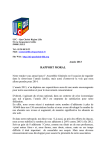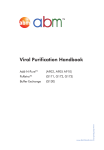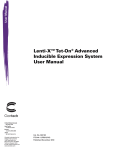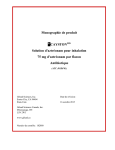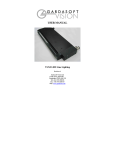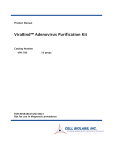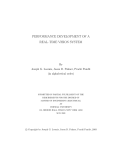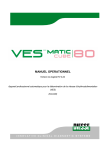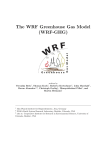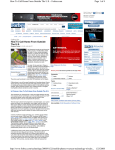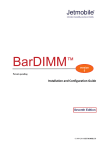Download The ViraPower™ Adenoviral Expression System, continued
Transcript
ViraPower™ Adenoviral Expression System A viral system for high-level, transient expression in dividing and non-dividing mammalian cells Catalog nos. K4930-00 and K4940-00 Version B 11 July 2005 25-0543 A Limited Use Label License covers this product (see Purchaser Notification). By use of this product, you accept the terms and conditions of the Limited Use Label License. Corporate Headquarters Invitrogen Corporation 1600 Faraday Avenue Carlsbad, CA 92008 T: 1 760 603 7200 F: 1 760 602 6500 E: [email protected] For country-specific contact information visit our web site at www.invitrogen.com User Manual ii Table of Contents Table of Contents ....................................................................................................................................................... iii Kit Contents and Storage ........................................................................................................................................... v Accessory Products ................................................................................................................................................... vi Introduction ....................................................................................................................... 1 Overview...................................................................................................................................................................... 1 The ViraPower™ Adenoviral Expression System ................................................................................................... 3 Biosafety Features of the System .............................................................................................................................. 5 Experimental Outline ................................................................................................................................................. 7 Methods.............................................................................................................................. 8 General Information ................................................................................................................................................... 8 Producing Adenovirus in 293A Cells ...................................................................................................................... 9 Amplifying Your Adenoviral Stock ....................................................................................................................... 14 Titering Your Adenoviral Stock.............................................................................................................................. 17 Transduction and Analysis...................................................................................................................................... 21 Troubleshooting........................................................................................................................................................ 23 Appendix .......................................................................................................................... 25 Recipes........................................................................................................................................................................ 25 Technical Service....................................................................................................................................................... 26 Purchaser Notification ............................................................................................................................................. 27 Product Qualification ............................................................................................................................................... 29 References .................................................................................................................................................................. 31 iii iv Kit Contents and Storage Types of Kits This manual is supplied with the kits listed below. Product Catalog no. ® ™ K4930-00 ViraPower Adenoviral Gateway Expression Kit ® ™ ViraPower Adenoviral Promoterless Gateway Expression Kit Expression Kit Components The ViraPower™ Adenoviral Expression Kits include the following components. For a detailed description of the contents of each component, see below. Components pAd/CMV/V5-DEST Gateway® Vector Catalog no. K4930-00 Catalog no. K4940-00 9 pAd/PL-DEST Gateway® Vector 9 9 293A Cell Line Shipping/Storage K4940-00 9 The ViraPower™ Adenoviral Expression Kits are shipped as described below. Upon receipt, store each component as detailed below. Item ® Shipping Storage pAd-DEST Gateway Vector Blue ice -20°C 293A Cell Line Dry ice Liquid nitrogen pAd-DEST Vectors Each ViraPower™ Adenoviral Expression Kit includes a destination vector (pAd/CMV/V5-DEST or pAd/PL-DEST) for cloning your DNA sequence of interest and a corresponding expression control vector. Refer to the pAd/CMV/V5DEST and pAd/PL-DEST Gateway® Vector manual for detailed information about the amount provided and instructions on how to use the vectors. The pAd/CMV/V5-DEST and pAd/PL-DEST Gateway® Vector manual is supplied with each ViraPower™ Adenoviral Expression Kit, and may also be downloaded from our Web site (www.invitrogen.com) or requested from Technical Service (page 26). 293A Cell Line Each ViraPower™ Adenoviral Expression Kit includes the 293A Cell Line to facilitate production of adenovirus. Refer to the 293A Cell Line manual for detailed information about the amount of cells provided and instructions on how to culture and maintain the cell line. The 293A Cell Line manual is supplied with each ViraPower™ Adenoviral Expression Kit, and may also be downloaded from our Web site (www.invitrogen.com) or requested from Technical Service (see page 26. v Accessory Products Introduction The products listed in this section may be used with the ViraPower™ Adenoviral Expression Kits. For more information, refer to our Web site (www.invitrogen.com) or call Technical Service (see page 26). Additional Products The reagents supplied in the ViraPower™ Adenoviral Expression Kits as well as other products suitable for use with the kits are available separately from Invitrogen. Ordering information is provided below. Item pAd/CMV/V5-DEST Gateway® Vector 6 µg pAd/PL-DEST Gateway® Vector 6 µg 293A Cell Line ™ Lipofectamine 2000 ® Opti-MEM I Reduced Serum Medium Phosphate-Buffered Saline (PBS), pH 7.4 ™ S.N.A.P. MidiPrep Kit vi Quantity Catalog no. V493-20 V494-20 6 3 x 10 cells, frozen R705-07 0.75 ml 11668-027 1.5 ml 11668-019 100 ml 31985-062 500 ml 31985-062 500 ml 10010-023 1L 10010-031 20 reactions K1910-01 Introduction Overview Introduction The ViraPower™ Adenoviral Expression System allows creation of a replicationincompetent adenovirus that can be used to deliver and transiently express your gene of interest in either dividing or non-dividing mammalian cells. The major components of the ViraPower™ Adenoviral Expression System include: • A choice of Gateway®-adapted adenoviral vectors that allow highly efficient generation of a recombinant adenovirus containing the gene of interest under the control of the human cytomegalovirus (CMV) immediate-early enhancer/promoter (pAd/CMV/V5-DEST) or a promoter of choice (pAd/PL-DEST) • An optimized cell line, 293A, which allows production and subsequent titering of the recombinant adenovirus • A control expression plasmid containing the lacZ gene which, when packaged into virions and transduced into a mammalian cell line, expresses β-galactosidase For more information about the adenoviral vectors, the corresponding positive control vector containing the lacZ gene, and Gateway® Technology, refer to the pAd/CMV/V5-DEST and pAd/PL-DEST Gateway® Vector manual. This manual is supplied with each ViraPower™ Adenoviral Expression Kit, and may also be downloaded from our Web site (www.invitrogen.com) or requested from Technical Service (see page 26). Advantages of the ViraPower™ Adenoviral System Use of the ViraPower™ Adenoviral Expression System to facilitate DNA virusbased expression of the gene of interest provides the following advantages: • Uses Gateway® Technology to allow highly efficient, rapid cloning of a gene of interest into a full-length adenoviral vector, bypassing the need for a shuttle vector and inefficient homologous recombination in human or bacterial cells • Allows generation of high titer adenoviral stocks (i.e. 1 x 109 pfu/ml in crude preparations and 1 x 1011 pfu/ml in concentrated preparations) • Efficiently delivers the gene of interest to actively dividing and non-dividing mammalian cells in culture or in vivo • Generates adenoviral constructs with such a high degree of efficiency and accuracy that the system is amenable for use in high-throughput applications or library transfer procedures • Allows production of a replication-incompetent virus that enhances the biosafety of the system and its use as a gene delivery vehicle 1 Overview, continued Purpose of this Manual This manual provides an overview of the ViraPower™ Adenoviral Expression System and provides instructions and guidelines to: 1. Transfect the pAd/CMV/V5-DEST or pAd/PL-DEST expression construct into the 293A Cell Line to produce an adenoviral stock. 2. Amplify the adenoviral stock. 3. Titer the adenoviral stock. 4. Use the amplified adenoviral stock to transduce your mammalian cell line of choice. 5. Assay for transient expression of your recombinant protein. For details and instructions to generate your expression construct using pAd/CMV/V5-DEST or pAd/PL-DEST, refer to the pAd/CMV/V5-DEST and pAd/PL-DEST Gateway® Vector manual. For instructions to culture and maintain the 293A producer cell line, refer to the 293A Cell Line manual. These manuals are supplied with the ViraPower™ Adenoviral Expression Kits, and are also available for downloading from our Web site (www.invitrogen.com) or by contacting Technical Service (see page 26). 2 The ViraPower™ Adenoviral Expression System Components of the ViraPower™ Adenoviral Expression System The ViraPower™ Adenoviral Expression System facilitates highly efficient, in vitro or in vivo delivery of a target gene to dividing and non-dividing mammalian cells using a replication-incompetent adenovirus. Based on the secondgeneration vectors developed by Bett et al., 1994, the ViraPower™ Adenoviral Expression System takes advantage of the Gateway® Technology to simplify and greatly enhance the efficiency of generating high-titer, recombinant adenovirus. • The first major component of the System is an E1 and E3-deleted, pAdDEST-based expression vector into which the gene of interest will be cloned. Expression of the gene of interest is controlled by the human cytomegalovirus (CMV) promoter (in pAd/CMV/V5-DEST) or the promoter of choice (in pAd/PL-DEST). The vector also contains the elements required to allow packaging of the expression construct into virions (e.g. 5′ and 3′ ITRs, encapsidation signal, adenoviral late genes). For more information about the pAd-DEST expression vectors, refer to the pAd/CMV/V5-DEST and pAd/PL-DEST Gateway® Vector manual. • The second major component of the System is an optimized 293A Cell Line that will be used to facilitate initial production, amplification, and titering of replication-incompetent adenovirus. The 293A cells contain a stably integrated copy of E1 that supplies the E1 proteins (E1a and E1b) in trans required to generate adenovirus. For more information about the 293A Cell Line, refer to the 293A Cell Line manual. You will transfect the pAd-DEST vector containing your gene of interest into 293A cells to produce a replication-incompetent adenovirus. You will next use the crude adenoviral stock to infect 293A cells to produce an amplified adenoviral stock. Once the adenoviral stock is amplified and titered, this hightiter stock can be used to transduce the recombinant adenovirus into the mammalian cell line of choice for expression of the recombinant protein of interest. How Adenovirus Works Adenovirus enters target cells by binding to the Coxsackie/Adenovirus Receptor (CAR) (Bergelson et al., 1997). After binding to the CAR, the adenovirus is internalized via integrin-mediated endocytosis (Russell, 2000) followed by active transport to the nucleus. Once in the nucleus, the early events are initiated (e.g. transcription and translation of E1 proteins), followed by expression of the adenoviral late genes and viral replication. Note that expression of the late genes is dependent upon E1. In the ViraPower™ Adenoviral Expression System, E1 is supplied by the 293A producer cells. The viral life cycle spans approximately 3 days. For more information about the adenovirus life cycle and adenovirus biology, refer to published reviews (Russell, 2000). continued on next page 3 The ViraPower™ Adenoviral Expression System, continued Recombinant Protein Expression Infection vs. Transduction In vivo Gene Delivery 4 After adenovirus is transduced into the target cell and is transported to the nucleus, it does not integrate into the host genome. Therefore, expression of your recombinant protein of interest: • Is typically detectable within 24 hours after transduction. • Is transient and will only persist for as long as the viral genome is present. For more information, see page 21. Note that we refer to viral infection in some procedures in this manual, and viral transduction in other procedures. These terms are defined below. • Infection: Applies to situations where viral replication occurs and infectious viral progeny are generated. Only cell lines that stably express E1 can be infected. • Transduction: Applies to situations where no viral replication occurs and no infectious viral progeny are generated. Mammalian cell lines that do not express E1 are transduced. In this case, you are using adenovirus as a gene delivery vehicle. The ViraPower™ Adenoviral Expression System is suitable for in vivo gene delivery applications. Many groups have successfully used adenoviral vectors to express a target gene in a multitude of tissues including skeletal muscle, lung, heart, and brain. For more information about target genes that have been successfully expressed in vivo using adenoviral-based vectors, refer to the published reviews (Russell, 2000; Wang and Huang, 2000; Wivel, 1999). Biosafety Features of the System Introduction The ViraPower™ Adenoviral Expression System is a second-generation system based on adenoviral vectors developed by Bett et al., 1994. This secondgeneration adenoviral system includes a number of safety features designed to enhance its biosafety. These safety features are discussed below. Information for European Customers The 293A Cell Line is genetically modified and carries adenovirus type 5 sequences. As a condition of sale, this product must be in accordance with all applicable local legislation and guidelines including EC Directive 90/219/EEC on the contained use of genetically modified organisms. Biosafety Features of the ViraPower™ Adenoviral System The ViraPower™ Adenoviral Expression System includes the following safety features: Biosafety Level 2 • The entire E1 region is deleted in the pAd/CMV/V5-DEST or pAd/PL-DEST expression vectors. Expression of the E1 proteins is required for the expression of the other viral genes (e.g. late genes), and thus viral replication only occurs in cells that express E1 (Graham et al., 1977; Kozarsky and Wilson, 1993; Krougliak and Graham, 1995). • Adenovirus produced from the pAd/CMV/V5-DEST or pAd/PL-DEST expression vectors is replication-incompetent in any mammalian cells that do not express the E1a and E1b proteins (Graham et al., 1977; Kozarsky and Wilson, 1993; Krougliak and Graham, 1995). • Adenovirus does not integrate into the host genome upon transduction. Because the virus is replication-incompetent, the presence of the viral genome is transient and will eventually be diluted out as cell division occurs. Despite the presence of the safety features discussed above, the adenovirus produced with this System can still pose some biohazardous risk since it can transduce primary human cells. For this reason, we highly recommend that you treat adenoviral stocks generated using this System as Biosafety Level 2 (BL-2) organisms and strictly follow all published guidelines for BL-2. Furthermore, exercise extra caution when creating adenovirus carrying potential harmful or toxic genes (e.g. activated oncogenes) or when producing large-scale preparations of virus (see the next page). For more information about the BL-2 guidelines and adenovirus handling, refer to the document, “Biosafety in Microbiological and Biomedical Laboratories”, 4th Edition, published by the Centers for Disease Control (CDC). This document may be downloaded from the Web at the following address: http://www.cdc.gov/od/ohs/biosfty/bmbl4/bmbl4toc.htm continued on next page 5 Biosafety Features of the System, continued Additional Cautions When Producing LargeScale Preparations of Virus The genomic copy of E1 in all 293 cell lines contains homologous regions of overlap with the pAd/CMV/V5-DEST and pAd/PL-DEST vectors. In rare instances, it is possible for homologous recombination to occur between the E1 genomic region in 293 cells and the viral DNA, causing the gene of interest to be replaced with the E1 region, and resulting in generation of a “wild-type”, replication-competent adenovirus (RCA) (Lochmuller et al., 1994). This event is most likely to occur during large-scale preparation or amplification of virus, and the growth advantages of the RCA allow it to quickly overtake cultures of recombinant adenovirus. To reduce the likelihood of propagating RCAcontaminated adenoviral stocks: • Use caution when handling all viral preparations, and treat as BL-2 (see the previous page and page 14 for more details). • Perform routine screening for the presence of wild-type RCA contamination after large-scale viral preparations. Suitable methods to screen for RCA contamination include PCR screening (Zhang et al., 1995) or supernatant rescue assays (Dion et al., 1996). • If RCA contamination occurs, perform plaque purification to re-isolate the recombinant adenovirus of interest. Note: As an alternative, E1-containing producer cell lines such as 911 (Fallaux et al., 1996) or PER.C6 (Fallaux et al., 1998) which contain no regions of homologous overlap with the adenoviral vectors can be used to help reduce the incidence of RCA generation. 6 Experimental Outline The diagram below describes the general steps required to express your gene of interest using the ViraPower™ Adenoviral Expression System. For instructions to generate your adenovirus expression clone using pAd/CMV/V5-DEST or pAd/PLDEST, refer to the pAd/CMV/V5-DEST and pAd/PL-DEST Gateway® Vector manual. attB1 DNA of interest attB2 ITR 5 pUC Adenovirus Expression Clone wt Ad5 (DE3) Amp icil lin Flow Chart o ri 1.Generate the adenoviral expression clone containing your DNA of TM and interest (see the pAd/PL-DEST pAd/CMV/V5-DESTTM manual for instructions). Digest the purified plasmid with Pac I to expose the ITRs. 2. Transfect the 293A producer cell line with your adenoviral expression clone. Harvest cells and prepare a crude viral lysate. 293A Producer Cell Line 3. Amplify the adenovirus by infecting 293A producer cells with the crude viral lysate. Determine the titer of your adenoviral stock. 4.Add the viral supernatant to your mammalian cell line of interest. Your Mammalian Cell Line of Interest Promoter gene of interest 5.Assay for recombinant protein of interest. 7 Methods General Information Important The ViraPower™ Adenoviral Expression System is designed to help you create an adenovirus to deliver and transiently express a gene of interest in mammalian cells. Although the system has been designed to help you express your recombinant protein of interest in the simplest, most direct fashion, use of the system is geared towards those users who are familiar with the biology of DNA viruses and adenoviral vectors. We highly recommend that users possess a working knowledge of viral and tissue culture techniques. For more information about these topics, refer to the following published reviews: Generating Your pAd-DEST Expression Clone • Adenovirus biology: see Russell, 2000 • Adenoviral vectors: see Hitt et al., 1999 and Wivel, 1999 • Adenovirus applications: see Wang and Huang, 2000 You will need to generate an expression clone containing your DNA sequence of interest in pAd/CMV/V5-DEST or pAd/PL-DEST. If you want to… Then use… Express your gene of interest under the control of the human CMV promoter pAd/CMV/V5-DEST Express your gene of interest under the control of your own promoter of choice pAd-DEST Refer to the pAd/CMV/V5-DEST and pAd/PL-DEST Gateway® Vector manual for instructions to create your expression clone. Once you have created your expression clone, use any method of choice to prepare purified plasmid DNA. Remember that plasmid DNA for transfection into eukaryotic cells must be clean and free from phenol and sodium chloride as contaminants may kill the cells, and salt will interfere with lipid complexing, decreasing transfection efficiency. We recommend isolating plasmid DNA using the S.N.A.P.™ MidiPrep Kit (Catalog no. K1910-01) or CsCl gradient centrifugation. 293A Cell Line The human 293A Cell Line is included with the ViraPower™ Adenoviral Expression kits to facilitate adenovirus production from the E1-deleted pAdDEST vectors. The 293A Cell Line, a subclone of the 293 cell line, supplies the E1 proteins in trans that are required for expression of adenoviral late genes, and thus viral replication. The cell line exhibits a flattened morphology, enabling easier visualization of plaques. For more information about how to culture and maintain 293A cells, refer to the 293A Cell Line manual. Note: Any 293-derived cell line or other cell line that expresses the E1 proteins may be used to produce adenovirus. 8 Producing Adenovirus in 293A Cells Introduction Once you have created a pAd-DEST expression clone, you will transfect the expression clone into 293A cells to produce an adenoviral stock. The following section provides protocols and instructions to generate an adenoviral stock. Preparing the Expression Clone for Use Before you can transfect your pAd-DEST expression clone into 293A cells, you must expose the left and right viral ITRs to allow proper viral replication and packaging. Each pAd-DEST vector contains Pac I restriction sites (refer to the maps of each vector in the pAd/CMV/V5-DEST and pAd/PL-DEST manual for the location of the Pac I sites). Digestion of the vector with Pac I allows exposure of the left and right viral ITRs and removal of the bacterial sequences (i.e. pUC origin and ampicillin resistance gene). Note: Make sure that your DNA sequence of interest does not contain any Pac I restriction sites. Materials Needed 1. Digest at least 5 µg of purified plasmid DNA of your pAd-DEST expression construct with Pac I (New England Biolabs, Catalog no. R0547S). Follow the manufacturer’s instructions. 2. Purify the digested plasmid DNA using phenol/chloroform extraction followed by ethanol precipitation or a DNA purification kit (e.g. Invitrogen’s S.N.A.P. MiniPrep™ Kit; Catalog no. K1900-01). Note: Gel purification is not required. 3. Resuspend or elute the purified plasmid, as appropriate in sterile water or TE Buffer, pH 8.0 to a final concentration of 0.1-3.0 µg/µl. You should have the following materials on hand before beginning: • Pac I-digested pAd-DEST expression clone containing your DNA sequence of interest (0.1-3.0 µg/µl in sterile water or TE, pH 8.0) • pAd/CMV/V5-GW/lacZ positive control vector (supplied with the kit; resuspend in sterile water to a concentration of 1 µg/µl) • 293A cells cultured in the appropriate medium (see the 293A Cell Line manual for details) • Transfection reagent suitable for transfecting 293A cells (e.g. Lipofectamine™ 2000; see the next page for more information) • Opti-MEM® I Reduced Serum Medium (if using Lipofectamine™ 2000; prewarmed; see the next page) • Fetal bovine serum (FBS) • Sterile, 6-well and 10 cm tissue culture plates • Sterile, tissue culture supplies • 15 ml sterile, capped, conical tubes • Table-top centrifuge • Water bath (set to 37°C) • Cryovials continued on next page 9 Producing Adenovirus in 293A Cells, continued Positive Control The pAd/CMV/V5-GW/lacZ plasmid is included with each ViraPower™ Adenoviral Expression kit as a positive control vector for expression. We recommend including the positive control vector in your transfection experiment to generate a control adenoviral stock that you may use to help you optimize expression conditions in your mammalian cell line of interest. To use pAd/CMV/V5-GW/lacZ as a positive control, you will need to digest the vector with Pac I using the protocol on the previous page. The Pac I-digested plasmid may then be used in your transfection experiment to generate an adenoviral stock. For more information about the positive control vector, refer to the pAd/CMV/V5-DEST and pAd/PL-DEST Gateway® Vector manual. Transfection Reagent You may use any suitable transfection reagent to introduce the pAd-DEST expression construct into 293A cells. We recommend using the cationic lipidbased Lipofectamine™ 2000 Reagent (Ciccarone et al., 1999) available from Invitrogen (see page vi for ordering information). Using Lipofectamine™ 2000 to transfect 293A cells offers the following advantages: • Provides the highest transfection efficiency in 293A cells • DNA-Lipofectamine™ 2000 complexes can be added directly to cells in culture medium in the presence of serum • Removal of complexes or medium change or addition following transfection are not required, although complexes can be removed after 4-6 hours without loss of activity Note: To facilitate optimal formation of DNA-Lipofectamine™ 2000 complexes, we recommend using Opti-MEM® I Reduced Serum Medium available from Invitrogen. For more information about Opti-MEM® I, see our Web site (www.invitrogen.com) or call Technical Service (see page 26). Recommended Transfection Conditions We generally produce adenoviral stocks in 293A cells using the following optimized transfection conditions below. The amount of adenovirus produced using these recommended conditions is approximately 10 ml of crude viral lysate with a titer ranging from 1 x 107 to 1 x 108 plaque-forming units (pfu)/ml. Note: We use Lipofectamine™ 2000 for transfection. If you are using another transfection reagent, follow the manufacturer’s instructions. Condition Amount Tissue culture plate size 6-well (one well per adenoviral construct) Number of 293A cells to transfect 5 x 105 cells (see Note below ) Amount of Pac I-digested pAd-DEST expression plasmid 1 µg Amount of Lipofectamine™ 2000 3 µl 293A cells should be plated 24 hours prior to transfection in complete medium, and should be 90-95% confluent on the day of transfection. Make sure that cells are healthy at the time of plating. continued on next page 10 Producing Adenovirus in 293A Cells, continued Transfection Procedure Follow the procedure below to transfect 293A cells using Lipofectamine™ 2000. Remember that you may keep the cells in culture medium during transfection. We recommend including a positive control and a negative control (no DNA, no Lipofectamine™ 2000) in your experiment to help you evaluate your results. 1. The day before transfection, trypsinize and count the 293A cells, plating them at 5 x 105 cells per well in a 6-well plate. Plate cells in 2 ml of normal growth medium containing serum. 2. On the day of transfection, remove the culture medium from the 293A cells and replace with 1.5 ml of normal growth medium containing serum (or OptiMEM® I Medium containing serum). Do not include antibiotics. 3. Prepare DNA-Lipofectamine™ 2000 complexes for each transfection sample by performing the following: • Dilute 1 µg of Pac I-digested pAd-DEST expression plasmid DNA in 250 µl of Opti-MEM® I Medium without serum. Mix gently. • Mix Lipofectamine™ 2000 gently before use, then dilute 3 µl in 250 µl of Opti-MEM® I Medium without serum. Mix gently and incubate for 5 minutes at room temperature. • After the 5 minute incubation, combine the diluted DNA with the diluted Lipofectamine™ 2000. Mix gently. • Incubate for 20 minutes at room temperature to allow the DNALipofectamine™ 2000 complexes to form. The solution may appear cloudy, but this will not impede the transfection. 4. Add the DNA-Lipofectamine™ 2000 complexes dropwise to each well. Mix gently by rocking the plate back and forth. Incubate the cells overnight at 37°C in a CO2 incubator. 5. The next day, remove the medium containing the DNA-Lipofectamine™ 2000 complexes and replace with complete culture medium (i.e. D-MEM containing 10% FBS, 2 mM L-glutamine, and 1% penicillin/streptomycin). 6. 48 hours post-transfection, trypsinize cells and transfer the contents of each well to a sterile 10 cm tissue culture plate containing 10 ml of complete culture medium. Caution: Remember that you are working with infectious virus at this stage and in all subsequent procedures. Follow the recommended guidelines for working with BL-2 organisms (see page 5 for more information). 7. Replace culture medium with fresh, complete culture medium every 2-3 days until visible regions of cytopathic effect (CPE) are observed (typically 7-10 days post-transfection). For an example, see the next page. 8. Replenish culture medium and allow infections to proceed until approximately 80% CPE is observed (typically 10-13 days post-transfection). 9. Harvest adenovirus-containing cells by squirting cells off the plate with a 10 ml tissue culture pipette. Transfer cells and media to a sterile, 15 ml, capped tube. Proceed to Preparing a Crude Viral Lysate, page 13. continued on next page 11 Producing Adenovirus in 293A Cells, continued Example of CPE In this example, Pac I-digested pAd/CMV/V5-GW/lacZ plasmid was transfected into 293A cells using the recommended protocol on the previous page. The photographs show transfected cells as they undergo CPE. Day 4-6 post-transfection At this early stage, cells producing adenovirus first appear as patches of rounding, dying cells. Day 6-8 post-transfection As the infection proceeds, cells containing viral particles lyse and infect neighboring cells. A plaque begins to form. Day 8-10 post-transfection At this late stage, infected neighboring cells lyse, forming a plaque that is clearly visible. continued on next page 12 Producing Adenovirus in 293A Cells, continued Preparing a Crude Viral Lysate After you have harvested adenovirus-containing cells and media, you will use several freeze/thaw cycles followed by centrifugation to prepare a crude viral lysate. The freeze/thaw cycles cause the cells to lyse and allow release of intracellular viral particles. 1. Place the tube containing harvested cells and media from Transfection Procedure, Step 9, page 11 at -80°C for 30 minutes. Remove tube and place in a 37°C water bath for 15 minutes to thaw. Repeat the freezing and thawing steps twice. Note: Do not incubate samples at 37°C for longer than 15 minutes. What to Do Next Long-Term Storage 2. Centrifuge the cell lysate in a table-top centrifuge at 3000 rpm for 15 minutes at room temperature to pellet the cell debris. 3. Transfer the supernatant containing viral particles to cryovials in 1 ml aliquots. Store the viral stocks at -80°C. Once you have prepared a crude viral stock, you may: • Amplify the viral stock by infecting 293A cells (see the next section for details). This procedure is recommended to obtain the highest viral titers and optimal results in your transduction studies. • Determine the titer (see pages 17-20 for instructions). • Use this viral stock to transduce your mammalian cells of interest to verify the functionality of your adenoviral construct in preliminary expression experiments (see pages 21-22 for more information). Place viral stocks at -80°C for long-term storage. Because adenovirus is nonenveloped, viral stocks remain relatively stable and some freezing and thawing of the viral stocks is acceptable. We do not recommend freezing and thawing viral stocks more than 10 times as loss of viral titer can occur. When stored properly, viral stocks of an appropriate titer should be suitable for use for up to one year. After long-term storage, we recommend re-titering your viral stocks before use. 13 Amplifying Your Adenoviral Stock Introduction Once you have created a crude viral stock, you can use this stock to infect 293A cells to generate a higher titer viral stock (i.e. amplify the virus). The titer of the initial viral stock obtained from transfecting 293A cells generally ranges from 1 x 107 to 1 x 108 plaque-forming units (pfu)/ml. Amplification allows production of a viral stock with a titer ranging from 1 x 108 to 1 x 109 pfu/ml and is generally recommended. Guidelines and protocols are provided in this section to amplify the recombinant adenovirus using 293A cells plated in a 10 cm dish. Larger-scale amplification is possible (see page 16). Note: Other 293 cell lines or cell lines expressing the E1 proteins are suitable. Remember that you will be working with infectious virus. Follow the recommended Federal guidelines for working with BL-2 organisms. • Perform all manipulations within a certified biosafety cabinet. • Treat media containing virus with bleach. • Treat used pipets, pipette tips, and other tissue culture supplies with bleach or dispose of as biohazardous waste. • Wear gloves, a laboratory coat, and safety glasses or goggles when handling viral stocks and media containing virus. We have not observed wild-type RCA contamination in small-scale (i.e. 3 x 106 293A cells plated in a 10 cm dish) adenoviral amplification using the protocol on page 15. However, if you plan to perform large-scale amplification of virus, we recommend screening for wild-type RCA contamination. Note that even in largescale preparations, contamination of adenoviral stocks with wild-type RCA is a rare event. For more information, see page 6. Materials Needed You should have the following materials on hand before beginning: • Crude adenoviral stock of your pAd-DEST construct (from Preparing a Crude Viral Lysate, Step 3, page 13) Note: If you have produced an adenoviral stock of the pAd/CMV/V5GW/lacZ construct, we recommend amplifying this viral stock as well • 293A cells cultured in the appropriate medium (see the 293A Cell Line manual for details) • Sterile 10 cm tissue culture plates • Sterile, tissue culture supplies • 15 ml sterile, capped, conical tubes • Table-top centrifuge • Water bath (set to 37°C) • Cryovials continued on next page 14 Amplifying Your Adenoviral Stock, continued Infection Conditions To amplify the adenoviral stock, we typically infect 293A cells using the following conditions: Condition Amount Tissue culture plate size 10 cm (one per adenoviral construct) Number of 293A cells to infect 3 x 106 cells Amount of crude adenoviral stock to use 100 µl (see Note below) We generally infect a 10 cm plate of 293A cells with 100 µl of untitered crude viral stock. Assuming a viral titer of 1 x 107 to 1 x 108 pfu/ml, this generally allows us to harvest the desired number adenovirus-containing cells 2-3 days after infection. You may vary the volume of crude viral stock used to infect cells, if desired. We have used up to 1 ml of crude viral stock. If you have determined the titer of your crude viral stock, we recommend infecting 293A cells at a multiplicity of infection (MOI) = 3 to 5. Amplification Procedure Follow the procedure below to amplify your adenoviral stock using 293A cells. Make sure that your 293A cells are healthy at the time of plating. 1. The day before infection, trypsinize and count the 293A cells, plating them at 3 x 106 cells per 10 cm plate. Plate cells in 10 ml of normal growth medium containing serum. 2. On the day of infection, verify that the cells are at 80-90% confluency before proceeding. Add the desired amount of crude adenoviral stock (e.g. 100 µl) to the cells. Swirl the plate gently to mix. 3. Incubate the cells at 37°C in a CO2 incubator and allow infection to proceed until 80-90% of the cells have rounded up and are floating or lightly attached to the tissue culture dish (typically 2-3 days post-infection). This indicates that cells are loaded with adenoviral particles. Note: If you have used less than 100 µl of crude viral stock or a lower titer stock for infection, you may need to perform a longer incubation. 4. Harvest adenovirus-containing cells by squirting cells off the plate with a 10 ml tissue culture pipette. Transfer cells and media to a sterile, 15 ml, capped tube. 5. Place the tube containing harvested cells and at -80°C for 30 minutes. Remove tube and place in a 37°C water bath for 15 minutes to thaw. Repeat the freezing and thawing steps twice. 6. Centrifuge the cell lysate in a table-top centrifuge at 3000 rpm for 15 minutes at room temperature to pellet the cell debris. 7. Transfer the supernatant containing viral particles to cryovials in 1 ml aliquots. Store the viral stocks at -80°C. For long-term storage, store as described on page 13. Proceed to Titering Your Adenoviral Stock, next section. continued on next page 15 Amplifying Your Adenoviral Stock, continued Scale-Up The amplification procedure is easily scalable to any size tissue culture dish or roller bottle. If you wish to scale up the amplification, remember that you will need to increase the number of cells and amount of crude viral stock and medium used in proportion to the difference in surface area of the culture vessel. Important Reminder: Remember to screen for the presence of wild-type RCA contamination in your amplified stock. Refer to published references for suitable screening protocols (Dion et al., 1996; Zhang et al., 1995). 16 Titering Your Adenoviral Stock Introduction Before proceeding to transduce the mammalian cell line of interest and express your recombinant protein, we highly recommend determining the titer of your adenoviral stock. While this procedure is not required for some applications, it is necessary if: • You wish to control the number of adenoviral particles introduced to each cell • You wish to generate reproducible expression results Guidelines and protocols are provided in this section. Experimental Outline Factors Affecting Viral Titer To determine the titer of an adenoviral stock, you will: 1. Plate 293A cells in 6-well tissue culture plates. 2. Prepare 10-fold serial dilutions of your adenoviral stock. 3. Infect 293A cells overnight with serial dilutions of adenoviral stock. 4. Perform a plaque assay by overlaying the infected 293A cells with an agarose/plaquing media solution. Allow 8-12 days for plaques to form. 5. Stain and count the number of plaques in each dilution A number of factors can influence viral titers including: • The size of your gene of interest. Titers will generally decrease as the size of the insert increases. The size of the wild-type adenovirus type 5 genome is approximately 35.9 kb. Studies have demonstrated that recombinant adenovirus can efficiently package up to 108% of the wild-type virus size from E1 and E3-deleted vectors (Bett et al., 1994). Taking into account the size of the elements required for expression from each pAd-DEST vector, make sure that your DNA sequence or gene of interest does not exceed the size indicated for efficient packaging (see table below). Vector Insert Size Limit pAd/CMV/V5-DEST 6.0 kb pAd/PL-DEST 7.5 kb • The characteristics of the cell line used for titering (see the next page for more information). • The age of your adenoviral stock. Viral titers may decrease with long-term storage at -80°C. If your adenoviral stock has been stored for 6 months to 1 year, we recommend titering or re-titering your adenoviral stock prior to use in an expression experiment. • Number of freeze/thaw cycles. A limited number of freeze/thaw cycles is acceptable, but viral titers can decrease with more than 10 freeze/thaw cycles. • Improper storage of your adenoviral stock. Adenoviral stocks should be aliquotted and stored at -80°C (see page 13 for recommended storage conditions). continued on next page 17 Titering Your Adenoviral Stock, continued Selecting a Cell Line We recommend using the 293A cell line supplied with the kit to titer your adenoviral stock. Other cell lines are suitable. If you wish to use another cell line, choose one with the following characteristics: • Must express the E1 proteins • Grows as an adherent cell line • Easy to handle • Exhibits a doubling time in the range of 18-25 hours • Non-migratory The titer of an adenoviral construct may vary depending on which cell line is chosen. If you have more than one adenoviral construct, we recommend that you titer all of the adenoviral constructs using the same mammalian cell line. Materials Needed Staining Reagents To determine the titer of your adenoviral construct, you should have the following materials on hand before beginning: • Your pAd-DEST adenoviral stock (store at -80°C until use) • 293A Cell Line or other appropriate mammalian cell line of choice (see above) • Complete culture medium for your cell line • 6-well tissue culture plates • 4% agarose (see Recipes, page 25; equilibrate to 65°C before use) • Plaquing media (normal growth medium containing 2% FBS; equilibrate to 37°C before use) • 5 mg/ml MTT solution or other appropriate reagent for staining (see Recipes, page 25; see below for alternatives) We recommend using the vital dye, 3-[4,5-Dimethylthiazol-2-yl]-2,5diphenyltetrazolium bromide; Thiazolyl blue (MTT) as a staining reagent to help visualize plaques. Other vital stains including Neutral Red (Sigma, Catalog no. N7005) are suitable. If you wish to use Neutral Red, prepare a 1% solution (100X stock solution) in water and store at +4°C. continued on next page 18 Titering Your Adenoviral Stock, continued Titering Procedure Follow the procedure below to determine the titer of your adenoviral stock using the 293A Cell Line or other appropriate cell line. You will use at least one 6-well plate for every adenoviral stock to be titered (six dilutions or one mock well and five dilutions). Note: If you have generated an adenoviral stock of the pAd/CMV/V5-GW/lacZ positive expression control, we recommend titering this stock as well. 1. The day before infection (Day 1), trypsinize and count the cells, plating them such that they will be 80-90% confluent at the time of infection. Incubate cells at 37°C overnight. Example: When using 293A cells, we generally plate 1 x 106 cells per well in a 6-well plate. 2. On the day of infection (Day 2), thaw your adenoviral stock and prepare 10fold serial dilutions ranging from 10-4 to 10-9. For each dilution, dilute the adenoviral construct into complete culture medium to a final volume of 1 ml. Do not vortex. 3. Remove the culture medium from the cells. Mix each dilution gently by inversion and add to one well of cells (total volume = 1 ml). 4. Swirl the plate gently to disperse the media. Incubate at 37°C overnight. 5. The following day (Day 3), remove the media containing virus and gently overlay the cells with 2 ml of agarose overlay solution per well. Prepare the agarose overlay solution (enough to overlay one 6-well plate at a time) as described below: • For one 6-well plate (2 ml overlay per well), gently mix 12 ml of prewarmed (at 37°C) plaquing media and 1.2 ml of pre-warmed (at 65°C) 4% agarose. Avoid formation of bubbles. • Apply the overlay to the cells by gently pipetting the overlay down the side of each aspirated well. Work quickly to prevent premature solidification. • Place the 6-well plate in a level tissue-culture hood at room temperature for 15 minutes or until the agarose overlay solidifies. Return the plate to a 37°C humidified CO2 incubator. 6. 2 days following the initial overlay (Day 5), gently overlay the cells with an additional 1 ml of agarose overlay solution per well. Prepare the agarose overlay solution as described in Step 5. Allow the agarose overlay to solidify before returning the plate to a 37°C humidified CO2 incubator. 7. Monitor the plates until plaques are visible (generally 8-12 days post-infection = Day 10-14). For each well, gently layer the 5 mg/ml MTT solution (1/10 the volume of the agarose overlay) on top of the solidified agar to stain. Make sure the MTT solution is evenly distributed over the entire surface of the well. Example: If each well contains 3 ml of agarose overlay, use 300 µl of 5 mg/ml MTT. 8. Incubate plates for 3 hours at 37°C. 9. Count the plaques and determine the titer of your adenoviral stock. continued on next page 19 Titering Your Adenoviral Stock, continued What You Should See When titering pAd/CMV/V5-DEST or pAd/PL-DEST adenoviral stocks using 293A cells, we generally obtain titers ranging from 1 x 108 to 1 x 109 pfu/ml. Adenoviral constructs with titers in this range are generally suitable for use in most applications. Note: If the titer of your adenoviral stock is less than 1 x 107 pfu/ml, we recommend producing a new adenoviral stock. See page 17 and the Troubleshooting section, page 23 for more tips and guidelines to optimize your viral yield. Concentrating Virus 20 For some applications, viral titers higher than 1 x 109 pfu/ml may be desired. It is possible to concentrate adenoviral stocks using a variety of methods (e.g. CsCl purification; Engelhardt et al., 1993) without significantly affecting their transducibility. Use of these methods allows generation of adenoviral stocks with titers as high as 1 x 1011 pfu/ml. Transduction and Analysis Introduction Once you have generated an adenoviral stock with a suitable titer, you are ready to transduce the adenoviral construct into the mammalian cell line of choice and assay for expression of your recombinant protein. Guidelines are provided below. Transient Expression The pAd/CMV/V5-DEST or pAd/PL-DEST adenoviral construct is replicationincompetent and does not integrate into the host genome. Therefore, once transduced into the mammalian cells of choice, your recombinant protein of interest will be expressed only as long as the viral genome is present. The adenovirus terminal protein (TP) covalently binds to the ends of the viral DNA, and helps to stabilize the viral genome in the nucleus (Russell, 2000). In actively dividing cells, the adenovirus genome is gradually diluted out as cell division occurs, resulting in an overall decrease in transgene expression over time (generally to background levels within 1-2 weeks after transduction). In nondividing cells (e.g. quiescent CD34+ cells) or animal tissues (e.g. skeletal muscle, neurons), transgene expression is more stable and can persist for as long as 6 months following transduction (Chen et al., 1999; Fan et al., 2000; Navarro et al., 1999). In actively dividing cells (i.e. doubling time of approximately 24 hours), we have found that transgene expression is generally detectable within 24 hours of transduction, with maximal expression observed at 48-96 hours (2-4 days) posttransduction. Expression levels generally start to decline by 5 days after transduction. In cell lines that exhibit longer doubling times or non-dividing cell lines, high levels of transgene expression typically persist for a longer time. If you are transducing the adenoviral construct into your mammalian cell line for the first time, we recommend performing a time course of expression to determine the optimal conditions for expression of your recombinant protein. Multiplicity of Infection (MOI) To obtain optimal expression of your gene of interest, you will need to transduce the adenoviral construct into your mammalian cell line of choice using a suitable MOI. MOI is defined as the number of virus particles per cell and generally correlates with expression. Typically, expression levels increase linearly as the MOI increases. Determining the Optimal MOI A number of factors can influence determination of an optimal MOI including the nature of your mammalian cell line (e.g. non-dividing vs. dividing cell type; see Note on the next page), its transduction efficiency, your application of interest, and the nature of your gene of interest. If you are transducing your adenoviral construct into the mammalian cell line of choice for the first time, we recommend using a range of MOIs (e.g. 0, 0.5, 1, 2, 5, 10, 20, 50) to determine the MOI required to obtain optimal expression of your recombinant protein for your particular application. continued on next page 21 Transduction and Analysis, continued In general, we have found that 80-90% of the cells in an actively dividing cell line (e.g. HT1080) express a target gene when transduced at an MOI of ~1. Other cell types including non-dividing cells may transduce adenoviral constructs less efficiently. If you are transducing your adenoviral construct into a non-dividing cell type, you may need to increase the MOI to achieve optimal expression levels for your recombinant protein. Positive Control Important Transduction Procedure Detecting Recombinant Protein 22 If you have generated the pAd/CMV/V5-GW/lacZ control adenoviral construct, we recommend using the adenoviral stock to help you determine the optimal MOI for your particular cell line and application. Once you have transduced the Ad/CMV/V5-GW/lacZ adenovirus into your mammalian cell line of choice, the gene encoding β-galactosidase will be constitutively expressed and can be easily assayed (refer to the pAd/CMV/V5-DEST and pAd/PL-DEST Gateway® Vector manual for details). Remember that viral supernatants are generated by lysing cells containing virus into spent media harvested from the 293A producer cells. Spent media lacks nutrients and may contain some toxic waste products. If you are using a large volume of viral supernatant to transduce your mammalian cell line (e.g. 1 ml of viral supernatant per well in a 6-well plate), note that growth characteristics or morphology of the target cells may be affected during transduction. These effects are generally alleviated after transduction when the media is replaced with fresh, complete media. Follow the procedure below to transduce the mammalian cell line of choice with your adenoviral construct. 1. Plate your mammalian cells of choice in complete media as appropriate for your application. 2. On the day of transduction (Day 1), thaw your adenoviral stock and dilute (if necessary) the appropriate amount of virus (at a suitable MOI) into fresh complete medium. Do not vortex. 3. Remove the culture medium from the cells. Mix the medium containing virus gently by pipetting and add to the cells. Swirl the plate gently to disperse the medium. Incubate at 37°C overnight. 4. The following day (Day 2), remove the medium containing virus and replace with fresh, complete culture medium. 5. Harvest the cells (if needed) on the desired day (e.g. 2 days post transduction) and assay for expression of your recombinant protein. You may use any method of choice to detect your recombinant protein of interest including functional analysis, immunofluorescence, or western blot. If you have cloned your gene of interest in frame with an epitope tag, you may detect your recombinant protein using an antibody to the epitope tag (see the pAd/CMV/V5DEST and pAd/PL-DEST Gateway® Vector manual for details). Troubleshooting Introduction Review the information in this section to troubleshoot your adenoviral expression experiments. Generating the Adenoviral Stock The table below lists some potential problems and possible solutions that may help you troubleshoot your transfection, amplification, and titering experiments. Problem Low viral titer No plaques obtained upon titering Titer indeterminable; cells completely lysed Reason Low transfection efficiency: • Incomplete Pac I digestion or digested DNA contaminated with phenol, ethanol, or salts • Unhealthy 293A cells; cells exhibit low viability • 293A cells plated too sparsely on the day before transfection • Plasmid DNA:transfection reagent ratio incorrect Solution • • • • Repeat the Pac I digestion. Make sure purified DNA is not contaminated with phenol, ethanol, or salts. Use healthy 293A cells; do not overgrow. Cells should be 90-95% confluent at the time of transfection. Optimize such that plasmid DNA (in µg):Lipofectamine™ 2000 (in µl) ratio ranges from 1:2 to 1:3. If you are using another transfection reagent, optimize according to the manufacturer’s recommendations. Viral supernatant too dilute Concentrate virus using CsCl purification (Engelhardt et al., 1993) or any method of choice. Viral supernatant frozen and thawed multiple times Do not freeze/thaw viral supernatant more than 10 times. Gene of interest is large Viral titers generally decrease as the size of the insert increases; inserts larger than 6 kb (for pAd/CMV/V5-DEST) and 7.5 kb (for pAd/PL-DEST) are not recommended. Gene of interest is toxic to cells Generation of constructs containing activated oncogenes or potentially harmful genes is not recommended. Viral stocks stored incorrectly Aliquot and store stocks at -80°C. Do not freeze/thaw more than 10 times. Incorrect titering cell line used Use the 293A cell line or any cell line with the characteristics discussed on page 18. Agarose overlay incorrectly prepared Make sure that the agarose is not too hot before addition to the cells; hot agarose will kill the cells. Viral supernatant not diluted sufficiently Titer adenovirus using 10-fold serial dilutions ranging from 10-4 to 10-9. continued on next page 23 Troubleshooting, continued Transducing Mammalian Cells Problem No expression Poor expression The table below lists some potential problems and possible solutions that may help you troubleshoot your transduction and expression experiment. Reason Solution Viral stocks stored incorrectly Aliquot and store stocks at -80°C. Do not freeze/thaw more than 10 times. Gene of interest contains a Pac I site Perform mutagenesis to change or remove the Pac I site. Poor transduction efficiency: • Mammalian cells not healthy • Non-dividing cell type used • • MOI too low Transduce your adenoviral construct into cells using a higher MOI. Low viral titer Amplify the adenoviral stock using the procedure on page 15. Adenoviral stock contaminated with RCA • • Persistent toxicity in target cells Screen for RCA contamination (Dion et al., 1996; Zhang et al., 1995). Prepare a new adenoviral stock or plaque purify to isolate recombinant adenovirus. Cells harvested too soon after transduction Do not harvest cells until at least 24 hours after transduction. Cells harvested too long after transduction For actively dividing cells, assay for maximal levels of recombinant protein expression within 5 days of transduction. Gene of interest is toxic to cells Generation of constructs containing activated oncogenes or potentially harmful genes is not recommended. Too much crude viral stock used • • • Wild-type RCA contamination 24 Make sure that your cells are healthy before transduction. Transduce your adenoviral construct into cells using a higher MOI. Reduce the amount crude viral stock used for transduction or dilute the crude viral stock. Amplify the adenoviral stock. Concentrate the crude viral stock. Screen for RCA contamination (Dion et al., 1996; Zhang et al., 1995). Plaque purify to isolate recombinant adenovirus or prepare a new adenoviral stock. Appendix Recipes 4% Agarose Follow the procedure below to prepare a 4% Agarose solution. Materials Needed: Ultra Pure Agarose (Invitrogen, Catalog no. 15510-027) Deionized, sterile water Protocol: 5 mg/ml MTT 1. Prepare a 4% stock solution in deionized, sterile water. 2. Autoclave at 121°C for 20 minutes to sterilize. 3. Equilibrate to 65°C in a water bath and use immediately or store at room temperature indefinitely. If you store the agarose solution at room temperature, you will need to melt the agarose before use. Microwave the agarose to melt, then equilibrate to 65°C in a water bath before use. Follow the procedure below to prepare a 5 mg/ml MTT solution. Materials Needed: 3-[4,5-Dimethylthiazol-2-yl]-2,5-diphenyltetrazolium bromide; Thiazolyl blue (MTT; Sigma, Catalog no. M2128) Phosphate-Buffered Saline (PBS; Invitrogen, Catalog no. 10010-023) Protocol: 1. Prepare a 5 mg/ml stock solution in PBS. 2. Filter-sterilize and dispense 5 ml aliquots into sterile, conical tubes. 3. Store at +4°C for up to 6 months. 25 Technical Service Web Resources Contact Us Visit the Invitrogen Web site at www.invitrogen.com for: • Technical resources, including manuals, vector maps and sequences, application notes, MSDSs, FAQs, formulations, citations, handbooks, etc. • Complete technical service contact information • Access to the Invitrogen Online Catalog • Additional product information and special offers For more information or technical assistance, call, write, fax, or email. Additional international offices are listed on our Web page (www.invitrogen.com). Corporate Headquarters: Invitrogen Corporation 1600 Faraday Avenue Carlsbad, CA 92008 USA Tel: 1 760 603 7200 Tel (Toll Free): 1 800 955 6288 Fax: 1 760 602 6500 E-mail: [email protected] Japanese Headquarters: Invitrogen Japan LOOP-X Bldg. 6F 3-9-15, Kaigan Minato-ku, Tokyo 108-0022 Tel: 81 3 5730 6509 Fax: 81 3 5730 6519 E-mail: [email protected] European Headquarters: Invitrogen Ltd Inchinnan Business Park 3 Fountain Drive Paisley PA4 9RF, UK Tel: +44 (0) 141 814 6100 Tech Fax: +44 (0) 141 814 6117 E-mail: [email protected] Material Data Safety Sheets (MSDSs) MSDSs are available on our Web site at www.invitrogen.com. On the home page, click on Technical Resources and follow instructions on the page to download the MSDS for your product. Limited Warranty Invitrogen is committed to providing our customers with high-quality goods and services. Our goal is to ensure that every customer is 100% satisfied with our products and our service. If you should have any questions or concerns about an Invitrogen product or service, contact our Technical Service Representatives. Invitrogen warrants that all of its products will perform according to specifications stated on the certificate of analysis. The company will replace, free of charge, any product that does not meet those specifications. This warranty limits Invitrogen Corporation’s liability only to the cost of the product. No warranty is granted for products beyond their listed expiration date. No warranty is applicable unless all product components are stored in accordance with instructions. Invitrogen reserves the right to select the method(s) used to analyze a product unless Invitrogen agrees to a specified method in writing prior to acceptance of the order. Invitrogen makes every effort to ensure the accuracy of its publications, but realizes that the occasional typographical or other error is inevitable. Therefore Invitrogen makes no warranty of any kind regarding the contents of any publications or documentation. If you discover an error in any of our publications, please report it to our Technical Service Representatives. Invitrogen assumes no responsibility or liability for any special, incidental, indirect or consequential loss or damage whatsoever. The above limited warranty is sole and exclusive. No other warranty is made, whether expressed or implied, including any warranty of merchantability or fitness for a particular purpose. 26 Purchaser Notification Introduction Use of the ViraPower™ Adenoviral Expression Kits is covered under a number of different licenses including those detailed below. Limited Use Label License No. 19: Cloning Technology Products This product and its use is the subject of one or more of U.S. Patent Nos. 5,888,732, 6,143,557, 6,171,861, 6,270,969, 6,277,608, and 6,720,140 and/or other pending U.S. and foreign patent applications owned by Invitrogen Corporation. The purchase of this product conveys to the buyer the non-transferable right to use the purchased amount of the product and components of the product in research conducted by the buyer (whether the buyer is an academic or for profit entity). The purchase of this product does not convey a license under any method claims in the foregoing patents or patent applications, or to use this product with any recombination sites other than those purchased from Invitrogen Corporation or its authorized distributor. The right to use methods claimed in the foregoing patents or patent applications with this product for research purposes only can only be acquired by the use of ClonaseTM purchased from Invitrogen Corporation or its authorized distributors. The buyer cannot modify the recombination sequence(s) contained in this product for any purpose. The buyer cannot sell or otherwise transfer (a) this product, (b) its components, or (c) materials made by the employment of this product or its components to a third party or otherwise use this product or its components or materials made by the employment of this product or its components for Commercial Purposes. The buyer may transfer information or materials made through the employment of this product to a scientific collaborator, provided that such transfer is not for any Commercial Purpose, and that such collaborator agrees in writing (a) not to transfer such materials to any third party, and (b) to use such transferred materials and/or information solely for research and not for Commercial Purposes. Notwithstanding the preceding, any buyer who is employed in an academic or government institution may transfer materials made with this product to a third party who has a license from Invitrogen under the patents identified above to distribute such materials. Transfer of such materials and/or information to collaborators does not convey rights to practice any methods claimed in the foregoing patents or patent applications. Commercial Purposes means any activity by a party for consideration and may include, but is not limited to: (1) use of the product or its components in manufacturing; (2) use of the product or its components to provide a service, information, or data; (3) use of the product or its components for therapeutic, diagnostic or prophylactic purposes; or (4) resale of the product or its components, whether or not such product or its components are resold for use in research. Invitrogen Corporation will not assert a claim against the buyer of infringement of the above patents based upon the manufacture, use or sale of a therapeutic, clinical diagnostic, vaccine or prophylactic product developed in research by the buyer in which this product or its components was employed, provided that none of (i) this product, (ii) any of its components, or (iii) a method claim of the foregoing patents, was used in the manufacture of such product. Invitrogen Corporation will not assert a claim against the buyer of infringement of the above patents based upon the use of this product to manufacture a protein for sale, provided that no method claim in the above patents was used in the manufacture of such protein. If the purchaser is not willing to accept the limitations of this limited use statement, Invitrogen is willing to accept return of the product with a full refund. For information on purchasing a license to use this product for purposes other than those permitted above, contact Licensing Department, Invitrogen Corporation, 1600 Faraday Avenue, Carlsbad, California 92008. Phone (760) 603-7200. continued on next page 27 Purchaser Notification, continued Limited Use Label License No. 28: CMV Promoter The use of the CMV promoter is covered under U.S. Patent Nos. 5,168,062 and 5,385,839 owned and licensed by the University of Iowa Research Foundation, 214 Technology Innovation Center, Iowa City, Iowa 52242. Limited Use Label License No. 116: Adenoviral Technology Products This product is covered by United States Patent No. 6,136,594, under which Invitrogen has been granted a limited right to provide products for research purposes. Your use of this product constitutes your agreement to use this product for internal research purposes only and not for any clinical, therapeutic, prophylactic, diagnostic or production use. If you do not agree to be bound by these terms, return the unopened container(s) to Invitrogen for a full refund. Information for European Customers The 293A Cell Line is genetically modified and carries adenovirus type 5 sequences. As a condition of sale, this product must be in accordance with all applicable local legislation and guidelines including EC Directive 90/219/EEC on the contained use of genetically modified organisms. 28 Commercial users must obtain a license to these patents directly from the University of Iowa Research Foundation. For further information, please contact the Associate Director of UIRF, at 319-335-4546. Product Qualification Introduction This section describes the criteria used to qualify the components of the ViraPower™ Adenoviral Expression Kits. Vectors Refer to the pAd/CMV/V5-DEST and pAd/PL-DEST Gateway® Vector manual for a description of the criteria used to qualify the adenoviral vectors. 293A Cell Line Each lot of cells is tested for cell growth and viability post-recovery from cryopreservation. The flat morphology is verified by visual inspection. Master Cell Banks are screened for viruses, mycoplasma, and sterility. Adenovirus Production Using the reagents provided in the kit, the pAd/CMV/V5-GW/lacZ plasmid is transfected into 293A cells using the protocol on page 11. Cells are harvested 10 days post-transfection, and a crude viral lysate is prepared using the protocol on page 13. The crude viral lysate is used to infect 293A cells, cells are harvested 3 days post-infection, and viral supernatant is prepared and titered. The pAd/CMV/V5-GW/lacZ adenoviral construct must demonstrate a titer of greater than 1 x 108 pfu/ml and must express functional β-galactosidase when transduced into HT1080 cells. 29 30 References Bergelson, J. M., Cunningham, J. A., Droguett, G., Kurt-Jones, E. A., Krithivas, A., Hong, J. S., Horwitz, M. S., Crowell, R. L., and Finberg, R. W. (1997). Isolation of a Common Receptor for Coxsackie B Viruses and Adenoviruses 2 and 5. Science 275, 1320-1323. Bett, A. J., Haddara, W., Prevec, L., and Graham, F. L. (1994). An Efficient and Flexible System for Construction of Adenovirus Vectors with Insertions or Deletions in Early Regions 1 and 3. Proc. Natl. Acad. Sci. USA 91, 8802-8806. Chen, H. H., Mack, L. M., Choi, S. Y., Ontell, M., Kochanek, S., and Clemens, P. R. (1999). DNA from Both High-Capacity and First-Generation Adenoviral Vectors Remains Intact in Skeletal Muscle. Hum. Gene Ther. 10, 365-373. Ciccarone, V., Chu, Y., Schifferli, K., Pichet, J.-P., Hawley-Nelson, P., Evans, K., Roy, L., and Bennett, S. (1999). LipofectamineTM 2000 Reagent for Rapid, Efficient Transfection of Eukaryotic Cells. Focus 21, 5455. Dion, L. D., Fang, J., and R.I. Garver, J. (1996). Supernatant Rescue Assay vs. Polymerase Chain Reaction for Detection of Wild Type Adenovirus-Contaminating Recombinant Adenovirus Stocks. J. Virol. Methods 56, 99-107. Engelhardt, J. F., Yang, Y., Stratford-Perricaudet, L. D., Allen, E. D., Kozarsky, K., Perricaudet, M., Yankaskas, J. R., and Wilson, J. M. (1993). Direct Gene Transfer of Human CFTR Into Human Bronchial Epithelia of Xenografts with E1-Deleted Adenoviruses. Nature Genetics 4, 27-34. Fallaux, F. J., Bout, A., Velde, I. V. d., Wollenberg, D. J. V. d., Hehir, K. M., Keegan, J., Auger, C., Cramer, S. J., Ormondt, H. V., Eb, A. J. V. d., Valerio, D., and Hoeben, R. C. (1998). New Helper Cells and Matched Early Region 1-Deleted Adenovirus Vectors Prevent Generation of Replication-Competent Adenoviruses. Hum. Gene Ther. 9, 1909-1917. Fallaux, F. J., Kranenburg, O., Cramer, S. J., Houweling, A., Ormondt, H. V., Hoeben, R. C., and Eb, A. J. V. d. (1996). Characterization of 911: A New Helper Cell Line for the Titration and Propagation of Early Region 1-Deleted Adenoviral Vectors. Hum. Gene Ther. 7, 215-222. Fan, X., Brun, A., Segren, S., Jacobsen, S. E., and Karlsson, S. (2000). Efficient Adenoviral Vector Transduction of Human Hematopoietic SCID-Repopulating and Long-Term Culture-Initiating Cells. Hum. Gene Ther. 11, 1313-1327. Graham, F. L., Smiley, J., Russell, W. C., and Nairn, R. (1977). Characteristics of a Human Cell Line Transformed by DNA from Human Adenovirus Type 5. J. Gen. Virol. 36, 59-74. Hitt, M. M., Parks, R. J., and Graham, F. L. (1999) Structure and Genetic Organization of Adenovirus Vectors. In The Development of Human Gene Therapy, T. Friedmann, ed. (Cold Spring Harbor, NY: Cold Spring Harbor Laboratory Press), pp. 61-86. Kozarsky, K. F., and Wilson, J. M. (1993). Gene Therapy: Adenovirus Vectors. Curr. Opin. Genet. Dev. 3, 499-503. Krougliak, V., and Graham, F. L. (1995). Development of Cell Lines Capable of Complementing E1, E4, and Protein IX Defective Adenovirus Type 5 Mutants. Hum. Gene Ther. 6, 1575-1586. 31 References Lochmuller, H., Jani, A., Huard, J., Prescott, S., Simoneau, M., Massie, B., Karpati, G., and Acsadi, G. (1994). Emergence of Early Region 1-Containing Replication-Competent Adenovirus in Stocks of Replication-Defective Adenovirus Recombinants (Delta E1 + Delta E3) During Multiple Passages in 293 Cells. Hum. Gene Ther. 5, 1485-1491. Navarro, V., Millecamps, S., Geoffroy, M. C., Robert, J. J., Valin, A., Mallet, J., and Salle, G. L. G. L. (1999). Efficient Gene Transfer and Long-Term Expression in Neurons Using a Recombinant Adenovirus with a Neuron-Specific Promoter. Gene Ther. 6, 1884-1892. Russell, W. C. (2000). Update on Adenovirus and its Vectors. J. Gen. Virol. 81, 2573-2604. Wang, I. I., and Huang, I. I. (2000). Adenovirus Technology for Gene Manipulation and Functional Studies. Drug Discovery Today 5, 10-16. Wivel, N. A. (1999) Adenoviral Vectors. In The Development of Human Gene Therapy, T. Friedmann, ed. (Cold Spring Harbor, NY: Cold Spring Harbor Laboratory Press), pp. 87-110. Zhang, W. W., Koch, P. E., and Roth, J. A. (1995). Detection of Wild-Type Contamination in a Recombinant Adenoviral Preparation by PCR. BioTechniques 18, 444-447. ©2002-2005 Invitrogen Corporation. All rights reserved. 32 Corporate Headquarters Invitrogen Corporation 1600 Faraday Avenue Carlsbad, CA 92008 T: 1 760 603 7200 F: 1 760 602 6500 E: [email protected] For country-specific contact information visit our web site at www.invitrogen.com User Manual









































